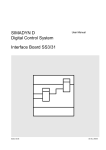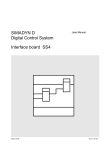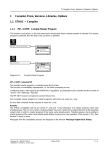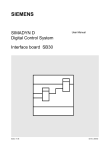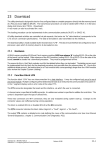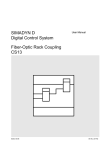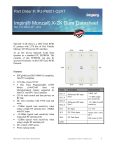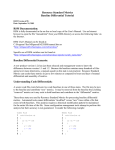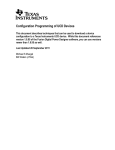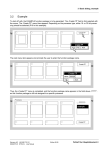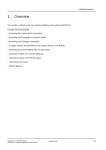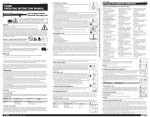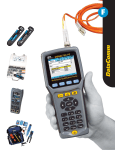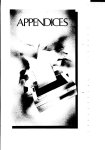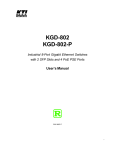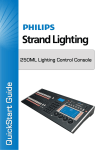Download Contents - Siemens
Transcript
8 IBS Program
Contents
Page
8 IBS Program .............................................................................................................................................. 8-3
8.1 Service .................................................................................................................................................... 8-4
8.1.1 Display Value ........................................................................................................................................ 8-6
8.1.2 Change Value ....................................................................................................................................... 8-7
8.1.3 DIsplay connection ................................................................................................................................ 8-8
8.1.4 Change connection ............................................................................................................................... 8-9
8.1.5 Repeat parameter set.......................................................................................................................... 8-11
8.1.6 Stepping through parameters .............................................................................................................. 8-11
8.1.7 Condense screen ................................................................................................................................ 8-11
8.1.8 Delete value........................................................................................................................................ 8-12
8.1.9 Reset service / monitor ....................................................................................................................... 8-12
8.1.10 Save commands and exit IBS ........................................................................................................... 8-12
8.1.11 Exit IBS............................................................................................................................................. 8-12
8.1.12 EXit program ..................................................................................................................................... 8-13
8.2 Macro..................................................................................................................................................... 8-13
8.2.1 Repeat entire macro............................................................................................................................ 8-13
8.2.2 Stepping through macro ...................................................................................................................... 8-15
8.2.3 New macro.......................................................................................................................................... 8-17
8.2.4 Edit macro........................................................................................................................................... 8-18
8.2.5 Condense Screen into macro .............................................................................................................. 8-20
8.2.6 Save actual parameters ...................................................................................................................... 8-22
8.3 Diagnostic .............................................................................................................................................. 8-23
8.3.1 PM 16 commands ............................................................................................................................... 8-23
8.3.2 Display Information ............................................................................................................................. 8-24
8.3.3 Display Address .................................................................................................................................. 8-25
8.3.4 Break monitor...................................................................................................................................... 8-26
8.3.5 PM 3 commands ................................................................................................................................. 8-26
8.3.6 Commands (storing)............................................................................................................................ 8-27
8.3.7 Hex dump ........................................................................................................................................... 8-28
8.3.8 Hex dump (single) ............................................................................................................................... 8-28
8.3.9 System information ............................................................................................................................. 8-29
8.3.10 System analyse................................................................................................................................. 8-29
8.3.11 Start debug monitor........................................................................................................................... 8-30
8.3.12 Reset service / monitor...................................................................................................................... 8-30
Siemens AG 465 983.7102.03
SIMADYN D TELEMASTER User manual
Edition 09.95
8-1
8 IBS Program
8-2
Edition 09.95
Siemens AG 465 983.7102.03
SIMADYN D TELEMASTER User manual
8 IBS Program
8
IBS Program
Using this IBS program, both the 16 bit (monitor) as well as the 32-bit generation (services)
from SIMADYN D can be used for communications. All active processors are displayed (32-bit
processors, inverse!). Up to 18 values can be displayed on the screen. However, for the 16-bit
generation, only a maximum of 10 values per processor can be updated (due to the monitor).
When a value is being updated, this can be identified by the flashing colon before the value.
Connections are shown and changed parallel to real-time display of current values. One macro
can display up to a maximum of 18 parameters. (There may be several macros; however, the
number depends on the amount of memory available). These values may be saved on the
hard disk or on a floppy diskette. Additional special commands permit fast and comprehensive
diagnostics.
The following should be observed when entering data:
The <- and -> keys move the cursor through the entry fields. To go from one field into the next
one to the right, you must press the TAB, CURSOR DOWN or POINT key; to reach the next
field to the left, use the SHIFT TAB or CURSOR UP key.
The IBS program is arranged in these 3 topic headings: Service, Macro, and Diagnostics.
Siemens AG 465 983.7102.03
SIMADYN D TELEMASTER User manual
Edition 09.95
8-3
8 IBS Program
8.1
Service
For the first four menu options - Display value, change value, display connection and change
connection the following is valid.
The following is possible if the cursor is positioned to the PN data entry field
8-4
a:
After a valid processor number has been entered, using the keys + and -, the
previous command can be re-displayed, so that if required it can be changed,
and then executed with RETURN.
b:
By entering t or T, values already displayed on the screen can be transferred to
the input line using the cursor control keys - processor, function package, function block or also connector (return with TAB).
c:
By clicking the mouse on already displayed processors, function packages,
function blocks, as well as connectors, then the appropriate parameters can be
transferred into the command line.
Edition 09.95
Siemens AG 465 983.7102.03
SIMADYN D TELEMASTER User manual
8 IBS Program
If path information, such as function package, function block or connector are missing, all of
those available are displayed in a dedicated window. If a $ without additional letters is entered
instead of a function package name, all projected $ signal names are displayed (only available
for PM3: option display value and display connection). If there are more than 60 (PM16:40)
function packages, function blocks, connectors or $ signal names, then a maximum of 60
(PM16:40) additional ones can be displayed by entering PAGE DOWN or by clicking the mouse
on the lower edge of the window. The previous page is selected by PAGE UP or clicking the
mouse on the upper edge of the window. The required name is transferred into the input line
via the cursor control keys or by directly clicking with the mouse, and the connector values are
requested using RETURN (by clicking on the mouse twice, this requests it directly).
Siemens AG 465 983.7102.03
SIMADYN D TELEMASTER User manual
Edition 09.95
8-5
8 IBS Program
8.1.1
Display Value
This command makes it possible to output analog and binary values. The syntax for this is as
follows:
PN: [n] FP- [xxxxxx] . [yyyyyy] . [zzz] [d]
n
xxxxxx
yyyyyy
zzz
d
:
:
:
:
:
is the processor number
function package
function block
connector
dimension (optional): H (hex) or B (binary)
If a $ is entered as the first character of the FP field, any input of function blocks and
connectors will no longer be considered, only a dimension specification.
Change value is directly selected by entering C (only if the cursor is in the PN-data entry field).
8-6
Edition 09.95
Siemens AG 465 983.7102.03
SIMADYN D TELEMASTER User manual
8 IBS Program
8.1.2
Change Value
This command makes it possible to change analog and binary values. The syntax for this is as
follows:
PN: [n] FP- [xxxxxx] . [yyyyyy] . [zzz]
n
xxxxxx
yyyyyy
zzz
:
:
:
:
is the processor number
function package
function block
connector
After the entry is completed correctly, the current value appears after the 'equals' sign (=) on
the top line. At this point you may enter a new value and any changes in the top line will be
monitored. As long as these changes have not yet been confirmed by pressing ENTER, you
may enter new values. If you press ENTER, you will be asked whether this new value should
be saved or not. If you press ENTER again, either with or without specifying N for no (N is the
default), the value is saved in the processor's RAM. If you enter a Y before pressing ENTER,
the value is saved in the processor's EEProm.
Please note: If you press the TAB key instead of ENTER at the Save Y/N question, the entry
will be updated, the cursor returns to the first entry field where you can make changes to
another value.
By entering D, the display value is directly selected (only if the cursor is in the PN data entry
field).
Siemens AG 465 983.7102.03
SIMADYN D TELEMASTER User manual
Edition 09.95
8-7
8 IBS Program
The following applies only to the PM3.
The value range window (connector attributes), displayed for a value which can be changed, is
closed using
function key F8.
If you want to change a value several times without the save Y/N question being made, value
changes are possible using the following function keys:
F1 : Initial value before the 1st change
F2 : Next to last value which was entered
F3 : Last value which was entered
8.1.3
DIsplay connection
This command displays the connections between the blocks. The syntax for this is as follows:
PN: [n] FP- [xxxxxx] . [yyyyyy] . [zzz]
n
xxxxxx
yyyyyy
zzz
:
:
:
:
is the processor number
function package
function block
connector
If a $ is entered as the first character of the FP field, any input of function blocks and
connectors will no longer be considered.
8-8
Edition 09.95
Siemens AG 465 983.7102.03
SIMADYN D TELEMASTER User manual
8 IBS Program
If a complete, valid path is specified, a window is displayed with the connections. If the window
is not adequate to display these, additional windows are opened by entering PAGE DOWN or
by clicking the mouse on the lower edge of the window (return with PAGE UP or by clicking the
mouse on the upper edge of the window).
8.1.4
Change connection
This command lets you change the connections.
PN: [n] FP- [xxxxxx] . [yyyyyy] . [zzz]
n
xxxxxx
yyyyyy
zzz
:
:
:
:
is the processor number
function package
function block
connector
After an input connector has been selected, the output connector (only the same function
package!), with the new connection can be entered.
Siemens AG 465 983.7102.03
SIMADYN D TELEMASTER User manual
Edition 09.95
8-9
8 IBS Program
If the connection is only to be disconnected, the following is valid:
PM3
: Enter #. The value, available at the time of
disconnection, is held at the appropriate input
connector.
PM16 : By entering a constant inside of the correct range of
value, the connection is opened and the constant is
connected at this input.
The question save Y/N should be responded to when depressing RETURN again after a value
change: With y or Y , and RETURN to save in the EEPROM, with n,N and return, or only with
RETURN (capitals are the default setting) for temporary storage.
If you press the TAB key instead of RETURN at the question save Y/N, the cursor returns to
the first entry field. This makes it possible to make entries again.
8-10
Edition 09.95
Siemens AG 465 983.7102.03
SIMADYN D TELEMASTER User manual
8 IBS Program
8.1.5
Repeat parameter set
This command calls up a macro with the name BUFFER.DAT and displays it. Before doing so,
the previously displayed values are deleted. This macro is created from the screen values
when the IBS program is exited via the menu selection Save commands and exit IBS.
8.1.6
Stepping through parameters
This command calls up a macro with the name BUFFER.DAT and displays it. This macro is
created from the screen values when the IBS program is exited via the menu selection Save
commands and exit IBS. However, it takes each value one at a time and links it to values
already available (18 values in maximum).
8.1.7
Condense screen
All values displayed here can be reassigned. By using the highlight bar and entering the code
T (Tag), or by clicking ('double-click') the left button of the mouse, you can mark the values in
increasing sequential order. To undo (de-select) all of your selections, use the code U (Untag),
or the right button of the mouse. The selections will be entirely reset. Press ENTER or click on
the screen selection Condense Screen with the left mouse button to call up all the marked
(tagged) values again. All non-tagged values then disappear.
Siemens AG 465 983.7102.03
SIMADYN D TELEMASTER User manual
Edition 09.95
8-11
8 IBS Program
8.1.8
Delete value
Use the highlight selection bar and enter the code T (Tag), or click ('double-click') with the left
mouse button, to select the values to delete. To undo (de-select) all of your selections, use the
code U (Untag), or the right button of the mouse. The selections will be entirely reset. Press
ENTER or click on the screen selection Delete Value with the left mouse button to delete all
the marked (tagged) values.
8.1.9
Reset service / monitor
This menu selection deletes the screen display and resets the SIMADYN D monitor and the
service program (P32).
8.1.10
Save commands and exit IBS
The save procedure saves the given commands as macro BUFFER.DAT, ends the program
and returns to the base menu. This procedure requires a few seconds to sign off the monitor
and to reset the interface. Then the menu can be rechosen with the function key F10.
8.1.11
Exit IBS
The exit IBS procedure ends the program and returns to the base menu. This procedure
requires a few seconds to sign off the monitor and to reset the interface. Then the menu can be
rechosen with the function key F10.
8-12
Edition 09.95
Siemens AG 465 983.7102.03
SIMADYN D TELEMASTER User manual
8 IBS Program
8.1.12
EXit program
The exit procedure ends the program completely and returns to the operating system. This
procedure requires a few seconds to sign off the monitor and to reset the interface.
8.2
Macro
In a single macro you can save up to 18 Display Value commands. The file name of the macro
may be a maximum of 8 characters long, and the file extension should be .DAT. While this file
extension is not necessarily required, it is recommended. By naming all macros .DAT, they are
easy to locate and distinguish from other files.
8.2.1
Repeat entire macro
All parameters stored in the macro are simultaneously called-up using this function, and
available screen values deleted. The function is aborted with a fault message if non-available
parameters are discovered.
Siemens AG 465 983.7102.03
SIMADYN D TELEMASTER User manual
Edition 09.95
8-13
8 IBS Program
A dialog window shows you all the macros that have been previously defined. From here, you
can select and retrieve the desired macro. You can switch back and forth between the upper
entry line (empty, but reserved) and the lower directory field by pressing the TAB key. Select
the desired macro by positioning the highlight bar over it using the cursor control keys, and then
press ENTER to retrieve it.
If you are using a mouse, position the mouse pointer on the desired macro and press the left
mouse button to select it. Then press the ENTER key to retrieve it. Optionally, you may
'double-click' on the desired macro to select and retrieve it immediately. To scroll through the
directory listing, you may click on the scroll bar arrow.
8-14
Edition 09.95
Siemens AG 465 983.7102.03
SIMADYN D TELEMASTER User manual
8 IBS Program
All values previously displayed on the screen are then deleted and the selected macro is
retrieved and displayed.
Function key F8: The macro contents are displayed.
8.2.2
Stepping through macro
This menu item is similar to the previous. However, when the macro is retrieved, the screen is
not deleted and the macro commands are called up individually, one after the other, and linked
to the values already shown on the screen as available. This procedure filters out unavailable
connectors, i.e. prevents them from being used in the macro.
Example:
If a macro 18 commands long has only 10 that are valid, then it is not necessary to reenter the
10 valid commands. This function is activated after processing the 10 commands, which may
then be saved under either a new name or the old. Before saving, you may enter up to 8
additional commands for the macro.
Siemens AG 465 983.7102.03
SIMADYN D TELEMASTER User manual
Edition 09.95
8-15
8 IBS Program
A dialog window shows you all the macros that have been previously defined. From here, you
can select and retrieve the desired macro. You can switch back and forth between the upper
entry line (empty, but reserved) and the lower directory field by pressing the TAB key. Select
the desired macro by positioning the highlight bar over it using the cursor control keys, and then
press ENTER to retrieve it.
If you are using a mouse, position the mouse pointer on the desired macro and press the left
mouse button to select it. Then press the ENTER key to retrieve it. Optionally, you may
'double-click' on the desired macro to select and retrieve it immediately. To scroll through the
directory listing, you may click on the scroll bar arrow.
Function key F8: The macro contents are displayed.
8-16
Edition 09.95
Siemens AG 465 983.7102.03
SIMADYN D TELEMASTER User manual
8 IBS Program
8.2.3
New macro
The function lets you create a macro from within your own dialog field, even if you do not have
a SIMADYN D monitor connection.
To create the macro, you may use most WordStar commands in the header line. To make it
easier to use, the following function keys have also been provided:
F1
F5
F9
home
copy
blockdel
F2 search
F6 blockwrite
F10 end
F3
F7
search/replace
blockread
F4
F8
repeat
blockmove
During editing, if you enter a period (dot), the cursor moves to the next grid field to the right. If
you are editing more than 18 lines, they will scroll up, toward and off, the top of the screen as
you add each line. When the macro is saved, it will contain more than 18 commands. However,
only the last 18 will be used when the macro is executed.
Exit by entering ESC and replying to the prompt: Save ? (Y/N).
Siemens AG 465 983.7102.03
SIMADYN D TELEMASTER User manual
Edition 09.95
8-17
8 IBS Program
8.2.4
Edit macro
You can edit a macro even if you do not have a SIMADYN D monitor connection. A dialog
window shows you all the macros that have been previously defined.
From here, you can select and retrieve the desired macro. You can switch back and forth
between the upper entry line (empty, but reserved) and the lower directory field by pressing the
TAB key. Select the desired macro by positioning the highlight bar over it using the cursor
control keys, and then press ENTER to retrieve it.
8-18
Edition 09.95
Siemens AG 465 983.7102.03
SIMADYN D TELEMASTER User manual
8 IBS Program
If you are using a mouse, position the mouse pointer on the desired macro and press the left
mouse button to select it. Then press the ENTER key to retrieve it. Optionally, you may
'double-click' on the desired macro to select and retrieve it immediately. To scroll through the
directory listing, you may click on the scroll bar arrow.
To edit the macro, you may use most WordStar commands in the header line. To make it
easier to use, the following function keys have also been provided:
F1
F5
F9
home
copy
blockdel
F2 search
F6 blockwrite
F10 end
F3
F7
search/replace
blockread
F4
F8
repeat
blockmove
During editing, if you enter a period (dot), the cursor moves to the next grid field to the right. If
you are editing more than 18 lines, they will scroll up, toward and off, the top of the screen as
you add each line. When the macro is saved, it will contain more than 18 commands. However,
only the last 18 will be used when the macro is executed.
Exit by entering ESC and replying to the prompt: Save ? (Y/N).
Siemens AG 465 983.7102.03
SIMADYN D TELEMASTER User manual
Edition 09.95
8-19
8 IBS Program
8.2.5
Condense Screen into macro
This function lets you assemble a macro on the screen and then save it under the name of your
choice with extensions .DAT. These commands may also be used later for other applications.
Therefore, when you assign the name, you should take into consideration the frame, the drive
number, and the function.
WARNING
The name will not be verified, i.e. for existing files,the old data will be overwritten.
By using the highlight bar and entering the code T (Tag), or by clicking ('double-click') the left
button of the mouse, you can mark the current values in increasing sequential order and save
them in a macro. To undo (de-select) all of your selections, use the code U (Untag), or the
right button of the mouse. The selections will be entirely reset. Press ENTER or click on the
screen selection Condense Screen into macro to save the values into a macro.
8-20
Edition 09.95
Siemens AG 465 983.7102.03
SIMADYN D TELEMASTER User manual
8 IBS Program
Siemens AG 465 983.7102.03
SIMADYN D TELEMASTER User manual
Edition 09.95
8-21
8 IBS Program
8.2.6
Save actual parameters
This function lets you save the commands available on the screen under the name of your
choice with extension .DAT. These commands may also be used later for other applications.
Therefore, when you assign the name, you should take into consideration the frame, the drive
number, and the function.
WARNING
The name will not be verified, i.e. for existing files,the old data will be overwritten.
8-22
Edition 09.95
Siemens AG 465 983.7102.03
SIMADYN D TELEMASTER User manual
8 IBS Program
8.3
Diagnostic
Additional commands and functions may be entered together under this menu selection.
8.3.1
PM 16 commands
Here you can enter the commands as you do from the pocket device.
Siemens AG 465 983.7102.03
SIMADYN D TELEMASTER User manual
Edition 09.95
8-23
8 IBS Program
8.3.2
Display Information
This command shows the function block type and the scanning times (both calculated and
actually used). The syntax for this is as follows:
PN: [n] FP- [xxxxxx] . [yyyyyy] . [zzz]
n
xxxxxx
yyyyyy
zzz
:
:
:
:
is the processor number
function package
function block
connector
If a $ is entered as the first character of the FP field, any input of function blocks and
connectors will no longer be considered.
The following is possible if the cursor is positioned to the PN data entry field
a:
After a valid processor number has been entered, using the keys + and -, the
previous command can be re-displayed, so that if required it can be changed,
and then executed with RETURN.
b:
By entering t or T, values already displayed on the screen can be transferred to
the input line using the cursor control keys - processor, function package,function block or also connector (return with TAB).
c:
By clicking the mouse on already displayed processors, function packages,
function blocks, as well as connectors, then the appropriate quantities can be
transferred into the command line.
If path information, such as function package, function block or connector are missing, all of
those available are displayed in a dedicated window. If there are more than 40 function
packages, function blocks or connectors, then a maximum of 40 additional ones can be
displayed by entering PAGE DOWN or by clicking the mouse on the lower edge of the window.
8-24
Edition 09.95
Siemens AG 465 983.7102.03
SIMADYN D TELEMASTER User manual
8 IBS Program
The previous page is selected by PAGE UP or clicking the mouse on the upper edge of the
window. The required name is transferred into the input line via the cursor control keys or by
directly clicking with the mouse, and the connector values are requested using RETURN (by
clicking on the mouse twice, this requests it directly).
8.3.3
Display Address
This command retrieves the address of a connector. The syntax
for this is as follows:
PN: [n] FP- [xxxxxx] . [yyyyyy] . [zzz] [E]
n
xxxxxx
yyyyyy
zzz
E
:
:
:
:
:
is the processor number
function package
function block
connector
Expanded address area (optional)
If a $ is entered as the first character of the FP field, any input of function blocks and
connectors will no longer be considered, except with the E option.
The following is possible if the cursor is positioned to the PN data entry field
a:
After a valid processor number has been entered, using the keys + and -, the
previous command can be re-displayed, so that if required it can be changed,
and then executed with RETURN.
b:
By entering t or T, values already displayed on the screen can be transferred to
the input line using the cursor control keys - processor, function package, function block or also connector (return with TAB).
Siemens AG 465 983.7102.03
SIMADYN D TELEMASTER User manual
Edition 09.95
8-25
8 IBS Program
c:
By clicking the mouse on already displayed processors, function packages,
function blocks, as well as connectors, then the appropriate quantities can be
transferred into the command line.
If path information, such as function package, function block or connector are missing, all of
those available are displayed in a dedicated window. If there are more than 40 function
packages, function blocks or connectors, then a maximum of 40 additional ones can be
displayed by entering PAGE DOWN or by clicking the mouse on the lower edge of the window.
The previous page is selected by PAGE UP or clicking the mouse on the upper edge of the
window. The required name is transferred into the input line via the cursor control keys or by
directly clicking with the mouse, and the connector values are requested using RETURN (by
clicking on the mouse twice, this requests it directly).
8.3.4
Break monitor
This selection aborts the continuous monitor output display.
8.3.5
PM 3 commands
PM3 commands can be entered in the hexadecimal format.
Example of a data input: 01 80 C8 AA FF
The hexadecimal values have the following significance:
01
80
C8
AA and FF
Processor number ( range 01 . . 08 )
Task number
( range 80 . . A0 )
Command code for mirror task
The telegram contents to be mirrored from the processor
Blanks between the individual hexadecimal values are not required; they are just used for
clarity. Only digits 0 . . 9, characters A . . F and blanks are accepted.
8-26
Edition 09.95
Siemens AG 465 983.7102.03
SIMADYN D TELEMASTER User manual
8 IBS Program
8.3.6
Commands (storing)
PM3 commands can be entered in the hexadecimal format. The commands and the associated
SIMADYN D responses are stored in a file with the name PM3.REC. This file is overwritten
after exiting this option and renewed execution!
Example of a data input: 01 80 C8 AA FF
The hexadecimal values have the following significance:
01
80
C8
AA and FF
Processor number ( range 01 . . 08 )
Task number
( range 80 . . A0 )
Command code for mirror task
The telegram contents to be mirrored from the
processor
Blanks between the individual hexadecimal values are not required; they are just used for
clarity. Only digits 0 . . 9, characters A . . F and blanks are accepted.
Siemens AG 465 983.7102.03
SIMADYN D TELEMASTER User manual
Edition 09.95
8-27
8 IBS Program
8.3.7
Hex dump
This can be used to automatically execute a text file with the name *.GET, which consists of
PM3 commands in the hexadecimal format. The commands and the associated SIMADYN D
responses are stored in a text file with the name *.PUT.
8.3.8
Hex dump (single)
This can be used to execute a text file with the name *.GET, which consists of PM3 commands
in the hexadecimal format, in individual steps (continue with space bar). The commands and
the associated SIMADYN D responses are stored in a text file with the name *.PUT.
8-28
Edition 09.95
Siemens AG 465 983.7102.03
SIMADYN D TELEMASTER User manual
8 IBS Program
8.3.9
System information
This menu item provides information regarding the selected processor.
8.3.10
System analyse
The fault field of the processor to be selected is stored in the file SIMDPNn.ERR (preliminary
stage before subsequent automatic fault analysis).
Siemens AG 465 983.7102.03
SIMADYN D TELEMASTER User manual
Edition 09.95
8-29
8 IBS Program
8.3.11
Start debug monitor
This menu item is used to start the debug monitor of the appropriate processor for
differentiated fault analysis. The services of this processor are interrupted. The debug monitor
can be handled via the processor-local connection line after the IBS program has been
terminated, and the services are returned by using "qq". (Not possible for PM16).
8.3.12
Reset service / monitor
This command deletes the screen entries and resets the service or / and the monitor.
8-30
Edition 09.95
Siemens AG 465 983.7102.03
SIMADYN D TELEMASTER User manual






























